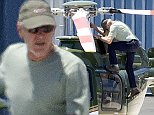Perfectly preserved: The 51 horse skeletons buried side-by-side in mass grave
Archaeologists have uncovered a mass grave containing the complete skeletons of 51 horses buried side-by-side.
The remains, discovered in the
Netherlands, probably belong to the long-forgotten equine victims of a
17th-century battle over a strategic Dutch river.
It was the largest known equine
burial ground in Europe, although chief archaeologist Angela Simons
said today that many such sites have probably existed but have been
ploughed up over the centuries by unwitting farmers.

Dig: Archaeologists have uncovered a mass grave containing the complete skeletons of 51 horses buried side-by-side, possibly belonging to the equine victims of a 17th-century Dutch battle
The archaeological team had been looking for evidence of prehistoric human settlements in the area when they made the find.
'From the first shovel, it was
horses, horses and more horses,' said Miss Simons, of the Hazenberg
company, who the Dutch government had hired to survey the ground ahead
of a construction project.
The horses showed signs of being
buried quickly - their bodies were not carefully arranged, and the
skeletons occasionally overlap.
'It's easy to imagine this is how cavalry men might dispose of dead mounts in war time,' Miss Simons said.
The horses may have been killed in battle, although disease or a plague could not be ruled out.
It also was unclear whether the horses were buried out of respect, or because of the fear of contamination from so many decomposing corpses.

Skeletons: The remains, discovered in the Netherlands, probably belong to the long-forgotten equine victims of a 17th-century battle over a strategic Dutch river
The skeletons were found in a ditch in a field near the Maas River in Borgharen, around two miles north of the Dutch border city of Maastricht.
Initial carbon testing dated the bones to the 17th century, when the Netherlands was still struggling to emerge as a nation.
If the horses were killed in a
battle, likely candidates include a fight in 1632 during the Eighty
Years' War, when Dutch rebels quartered in Borgharen resisted a
surprise charge by the Spanish cavalry.
Another possibility is the 1673 siege of Maastricht by soldiers of French 'Sun King' Louis XIV.
That battle is considered a milestone in siege warfare, because of how the attacking French used zigzagging ditches to give their soldiers cover from the city's battlements.
Both engagements were fought during the summer.


Burial: The horses may have been killed in battle, although disease or a plague could not be ruled out
No traces of bridles or saddles were
found in the shallow 130 foot-long grave, suggesting they were removed.
The researchers discovered just one stirrup and several horseshoes.
One horse had a bullet in its skull
just behind the eye-socket, probably an injured horse shot to prevent
further suffering, Miss Simons said.
Evidence suggests they were cavalry
horses. Most appeared to be around four years old, and their size and
bone structure suggests they were for riding, not draft horses.
Miss Simons said it was possible the
animals had some connection with several French soldiers whose
skeletons were uncovered on a riverbank in Borgharen in 2004.
The human skeletons were identified as French from their coat buttons.
-
 Genesis Rodriguez Gomez collapses during a lift attempt
Genesis Rodriguez Gomez collapses during a lift attempt
-
 Shocking new footage of ISIS massacre in Tikrit
Shocking new footage of ISIS massacre in Tikrit
-
 Shocking video shows driver barrel into four women
Shocking video shows driver barrel into four women
-
 Awkward moment Federer sidesteps Djokovic in corridor
Awkward moment Federer sidesteps Djokovic in corridor
-
 Mexico's Attorney Genral tours site of Guzman escape
Mexico's Attorney Genral tours site of Guzman escape
-
 Appalachian Bear Rescue save black bear cub
Appalachian Bear Rescue save black bear cub
-
 Solar cycle: The sun's 11-year heartbeat explained
Solar cycle: The sun's 11-year heartbeat explained
-
 Mexico's Security Commissioner on Guzman's prison escape
Mexico's Security Commissioner on Guzman's prison escape
-
 'El Chapo' Guzman taken into Altiplano prison back in 2014
'El Chapo' Guzman taken into Altiplano prison back in 2014
-
 Djokovic tries and fails to rip shirt off during Wimbledon...
Djokovic tries and fails to rip shirt off during Wimbledon...
-
 Real estate agents produce amazing video to sell $33m home
Real estate agents produce amazing video to sell $33m home
-
 'El Chapo' Guzman escorted to prison by helicopter in 2014
'El Chapo' Guzman escorted to prison by helicopter in 2014
-
 'I'm going to make you eat your words': Mexico's...
'I'm going to make you eat your words': Mexico's...
-
 Stunning Serena proves JK Rowling was spot on! Williams wows...
Stunning Serena proves JK Rowling was spot on! Williams wows...
-
 The hole that led the world's most wanted man to freedom......
The hole that led the world's most wanted man to freedom......
-
 Apple announces updates for its new operating system......
Apple announces updates for its new operating system......
-
 'Yes, my hands are full! Sometimes with glasses of wine':...
'Yes, my hands are full! Sometimes with glasses of wine':...
-
 ISIS's female Gestapo wreaking terror on their own sex: They...
ISIS's female Gestapo wreaking terror on their own sex: They...
-
 Donald Trump demands apology from his critics after escape...
Donald Trump demands apology from his critics after escape...
-
 John Gotti personally executed the real-life Joe Pesci...
John Gotti personally executed the real-life Joe Pesci...
-
 Bill Cosby's wife claims alleged victims 'consented' to...
Bill Cosby's wife claims alleged victims 'consented' to...
-
 #ThisIsACoup: Greeks react with fury at new €86bn EU bailout...
#ThisIsACoup: Greeks react with fury at new €86bn EU bailout...
-
 The heroes risking their lives to free ISIS sex slaves...
The heroes risking their lives to free ISIS sex slaves...
-
 Executed at dawn: Veiled woman terrorist who killed American...
Executed at dawn: Veiled woman terrorist who killed American...








































































































































































































































